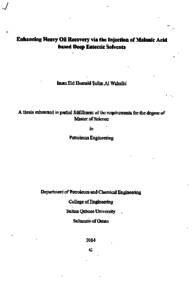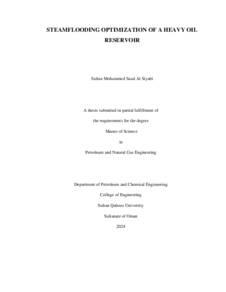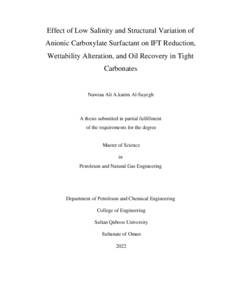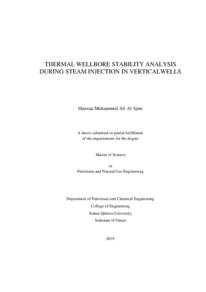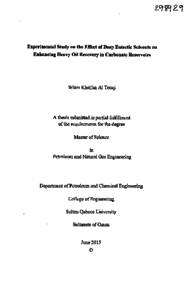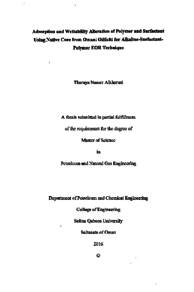وثيقة
Enhancing heavy oil recovery via the injection of malonic acid based deep eutectic solvents
الناشر
Sultan Qaboos University
ميلادي
2014
اللغة
الأنجليزية
الملخص الإنجليزي
Increasing demand and decreasing supply of crude oil have spurred efforts towards enhancing heavy oil recovery. Recently, applications of ionic liquids (ILs) for heavy oil. recovery and catalytic upgrading have been reported. However, ILs are generally considered too expensive for industrial applications. Moreover, certain types of ILs are non-biodegradable and toxic. An alternative class of ILs called Deep Eutectic Solvents (DESs) have recently been discovered and investigated upon. A DES generally composed of two or more components that are capable of self-association, to form eutectic mixture with a melting point lower than that of each individual component. DESS are non-toxic, biodegradable, recyclable, non-flammable, environmentally friendly and cheap. Therefore, DESs have found application in fields like extraction/separation, solvent development/reaction medium, and hydrometallurgy. This study investigates the potential of chemical solvents synthesized from DESs to recover the residual heavy oil. For the first time to our knowledge, the effectiveness of DESs - Choline Chloride: Malonic Acid (1:1) and (1:0.5) molar ratio - in enhancing heavy oil recovery is thoroughly investigated. Measurements of surface tension, interfacial tension, wettability alteration, spontaneous imbibitions, emulsification and formation damage tests were conducted at different temperatures. Heavy oil with 16 °API and formation brine from Middle East oil field were used. The core flood experiments were conducted using 200 300 md Berea sandstone cores. It was found that the solvents produced 7-14% of the residual heavy oil after brine flooding as tertiary recovery stage. The results showed that the two DESs make no emulsion with the heavy oil. Interfacial tension increased from 8.3 mNm for the oil-brine system to up to 21.9 mNm" for oil-DES system. On the other hand, the two DESs altered the wettability of the sandstone rock from strongly oil-wet to neutral-wet conditions. As temperature increases, the interfacial tension and oil recovery increase and wettability becomes more neutral-wet. Hence, wettability alteration is believed to be the main mechanism causing the enhancement in heavy oil recovery. The formation damage test proved that the tested DESs caused no damage to the formation where the absolute permeability before and after injecting the DES's was found the same.
الوصف
Thesis
المجموعة
URL المصدر
الملخص العربي
حفزت زيادة الطلب و انخفاض الإنتاج من النفط الخام الى تعزيز الجهود الرامية إلى تطوير طرق استخلاص النفط الثقيل باستخدام تقنيات متطورة وحديثة . مؤخرا ، تم طرح عدد من التجارب البحثية في التطبيقات المختلفة للسوائل الأيونية لاستخراج النفط الثقيل وتطوير المواد الكيميائية الحفازة. ومع ذلك، تعتبر السوائل الأيونية عموما مكلفة للغاية التطبيقات الصناعية. وعلاوة على ذلك ، هنالك أنواع معينة منها غير قابلة للتحلل و تسبب ضررا سميا للبيئة. وقد تم مؤخرا اكتشاف محاليل بديلة للسوائل الأيونية تدعی المذيبات ذات درجات الانصهار المنخفضة. وهذه المحاليل تتألف عادة من اثنين أو أكثر من المكونات القادرة على الارتباط الذاتي لتشكيل خليط نقطة انصهاره أقل من نقطة انصهار كل مكون على حدة. والجدير بالذكر أن هذة المحاليل غير سامة و قابلة للتحلل و قابلة لإعادة التدوير و غير قابلة للاشتعال و صديقة للبيئة ورخيصة. وبالتالي هي جيدة للتطبيقات في مجالات مثل الإستخلاص وفصل المواد الكيميائية و استخدامها كوسط للتفاعل و معالجة المواد الخام . تبحث هذه الدراسة إمكانية استخدامها لاستخلاص النفط الثقيل من حقول النفط العمانية لأول مرة تم اجراء الأبحاث لدراسة فعالية محلول : Choline Chloride Malonic Acid في تعزيز استخراج النفط الثقيل باستخدام نسب مولية مختلفة من المركبين . وقد أجريت قياسات التوتر السطحي و خاصية الالتصاق للسوائل على الصخور بأساليب مختلفة، و. خاصية الاستحلاب ودراسة الضرر على الصخور و قد تمت الإختبارات في درجات حرارة مختلفة. واستخدم النفط الثقيل.ذو 16( API) لزوجة تعادل 400 ملي نيوتن / ثانية و محلول ملحي من احدى حقول النفط العمانية . وأجريت التجارب باستخدام صخور نفاذيتها تعادل 200 إلى 300 ملي دارسي. وقد اوجدت النتائج أن فعالية هذه المحاليل في استخلاص النفط وصلت الى 7- 14 ٪ من النفط الثقيل المتبقي بعد شطفها بالمحلول الملحي. وأظهرت النتائج أن هذه المحاليل غير قادرة على تكوين مستحلب مع النفط الثقيل وذلك بسبب زيادة التوتر السطحي بين النفط والمحاليل وتصل شدة التوتر من 8 3. ملي نيوتن/متر ليصل إلى 21.9 ملي نيوتن متر. من ناحية أخرى، فان المحاليل التي تمت دراستها تمتلك قابلية تغيير خصائص سطح الصخر لتقلل من قوة التصاق النفط بها . كلما ترتفع درجة الحرارة، يقل التوتر السطحي وتزيد نسبة استخراج النفط بالاضافة الى زيادة قابلية تغير خصائص سطح الصخر. فقد أكدت النتائج المخبرية ان و خاصية الالتصاق للسوائل على الصخور انها هي الآلية الرئيسية التي تسبب في زيادة استخراج النفط الثقيل . أثبت النتائج المخبرية عدم امكانية تسبب المحلول الكيميائي في احداث ضرر للصخر حيث تم العثور على نفس قيمة النفاذية المطلقة قبل وبعد حقن في نفس المحلول الكيميائي
قالب العنصر
الرسائل والأطروحات الجامعية

